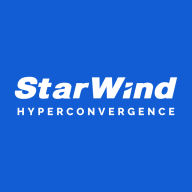


StarWind Storage Appliance and Dell PowerStore are prominent products in the enterprise storage solutions market. Users generally favor the pricing and support of StarWind, while Dell PowerStore is preferred for its advanced features.
Features: StarWind Storage Appliance offers simplicity, scalability, and straightforward management. Dell PowerStore provides intelligent automation, native cloud integration, and advanced data reduction capabilities. Dell PowerStore's additional features attract enterprises needing comprehensive solutions.
Room for Improvement: Users suggest StarWind could improve by enhancing performance analytics, offering more integration options, and refining user interface design. Dell PowerStore needs easier integration with third-party tools, improved user training resources, and optimized maintenance processes. Each product has distinct areas for enhancement to better support enterprise needs.
Ease of Deployment and Customer Service: StarWind Storage Appliance is praised for its straightforward deployment process and responsive customer service. Dell PowerStore offers detailed deployment options but is seen as complex, with mixed feedback on its deployment ease. Dell's customer service is efficient but less personalized compared to StarWind. StarWind typically provides a smoother initial setup experience.
Pricing and ROI: StarWind Storage Appliance is recommended for competitive upfront costs and quick ROI. Dell PowerStore, though more expensive, is considered a worthwhile long-term investment due to its extensive features. StarWind is more cost-effective initially, but Dell PowerStore may provide better long-term value.
By opting for the gold subscription every three years, you get a free upgrade to the latest controller release.
If you wait more than seven years to buy another one, you get a return on your investment.
If you purchase storage with 300 terabytes, you can easily achieve one petabyte of effective capacity.
It's been trouble-free the entire time, with very high performance, as it has been designed and built properly.
We have seen a return on our investment in Dell PowerStore; definitely our cost per terabyte has been very good compared to some of the other vendors that we would have been using previously, and our performance benchmarks have exceeded what we were expecting.
We also had one outage where a controller of one of the products had failed and had to be replaced on-site.
Customers always have their issues resolved promptly.
Pure has good storage.
If necessary, they will search for a specialist within their Dell network who we can approach with our questions.
I would rate the technical support of Dell PowerStore between nine and ten out of ten.
They're responsive, knowledgeable, and have a quick turnaround.
It is highly scalable.
It is suitable for both medium-sized and enterprise businesses.
It hasn't broken down anytime in the last six to seven years, despite hurricanes, earthquakes, and power outages.
The solution's scalability is a ten out of ten.
The customer likely exceeds 20,000 users globally.
You can create as many tools as needed, providing scalability based on the use case.
During the eight years, there have been no problems such as hardware failure or stopping.
I would rate the stability of the solution as a ten out of ten.
I would rate the stability of the product at seven out of ten.
When I removed all the cables, it failed over within five minutes.
There are no bugs or glitches and it doesn't crash or freeze.
I would rate the stability of Dell PowerStore as ten out of ten.
We would appreciate a built-in transparent failover in the next release to eliminate the need for a separate metro cluster.
I'm eagerly anticipating the roadmap's promise of introducing multiple controllers, which could significantly boost scalability and resilience.
We mostly rely on long-term releases. We don't need the most up-to-date features, but we need a reliable environment.
If you want to delve into where your I/Os are going, the reporting might need more in-depth information to make informed decisions.
In my organization, we have had to go through two weeks with no replication, which is not very handy for our production environment.
Something needs to be done with the caching to ensure that if some issue occurs, there needs to be an ability to disable caching during maintenance to make it static, safe, and good.
While the prices may be higher than those of other vendors, we see it as a market leader with benefits.
The support can be a bit pricey, but the solution is more cost-effective than anything else out there.
I would give it a nine out of ten in terms of costliness.
Likely the cost is $400,000 whereas IBM may be $250,000.
Based on my experience, the cost of Dell PowerStore for around 500 GB of capacity is very competitive compared to any other platform in the market.
There's no need to pay for a license; it's all-inclusive.
Pure Storage has signature security technology, which cannot be deleted, even if you are an administrator.
The platform's robust features include excellent sustainability tracking, and a comprehensive dashboard offering insights into IOPS, bandwidth, performance, and virtual activities.
Its data compression feature is the best that we have ever seen.
The solution promotes data reduction, often meeting the compression ratio.
The PowerStore's compression ratio is even higher than the Unity system.
The deduplication part of the solution is valuable since, as a user, you get more space for less money.



| Company Size | Count |
|---|---|
| Small Business | 15 |
| Midsize Enterprise | 11 |
| Large Enterprise | 12 |
| Company Size | Count |
|---|---|
| Small Business | 41 |
| Midsize Enterprise | 27 |
| Large Enterprise | 61 |
| Company Size | Count |
|---|---|
| Small Business | 5 |
| Midsize Enterprise | 3 |
| Large Enterprise | 2 |
Pure Storage FlashArray//X is the world’s first enterprise-class, all-NVMe flash storage array. It represents a new class of storage – shared accelerated storage, which is a term coined by Gartner – that delivers major breakthroughs in performance, simplicity, and consolidation.
Dell PowerStore is a scalable, high-performance platform supporting both modern and traditional workloads, enhancing IT operations with AI-driven automation and advanced data reduction features.
Designed for flexibility, Dell PowerStore integrates seamlessly with VMware, providing robust security and high IOPS. Users benefit from fast NVMe storage, intelligent data management, and scalable performance to handle diverse workload demands. However, improvements are needed in replication, enterprise functionalities, and UI complexity. Stability and support issues highlight the need for enhanced monitoring and pricing strategies.
What are the key features of Dell PowerStore?In industries like finance, healthcare, and IT, Dell PowerStore is critical for VMware virtualization, high-performance databases, and backup storage. It supports hosting virtual machines, mirroring storage, and handling SAP and Oracle databases effectively. Its role in hybrid and on-premises setups showcases its adaptability and integration capabilities for mission-critical tasks.
For SMB and Enterprises who are looking for high performance primary storage for server virtualization, VDI, database and Big Data scenarios, or inexpensive secondary backup tier, our solution is StarWind Storage Appliance. It unifies commodity servers, disks and flash, and associated software into an easily scalable storage platform.
Additionally, the appliance features an optional gateway to Azure public cloud, which helps to implement an effective Disaster Recovery plan or meet regulatory requirements. StarWind SA scales up by adding individual disks and flash modules, or JBODs, while adding ready controller nodes allows scaling out.
StarWind SA targets those, who need high-performance primary storage or secondary storage for backup. In case there is a whole virtualization infrastructure to build from scratch, StarWind HCA will come in handy. Otherwise, if all the required hardware is present, StarWind Virtual SAN will be enough to build a high-performance virtualization setup.
We monitor all NAS reviews to prevent fraudulent reviews and keep review quality high. We do not post reviews by company employees or direct competitors. We validate each review for authenticity via cross-reference with LinkedIn, and personal follow-up with the reviewer when necessary.